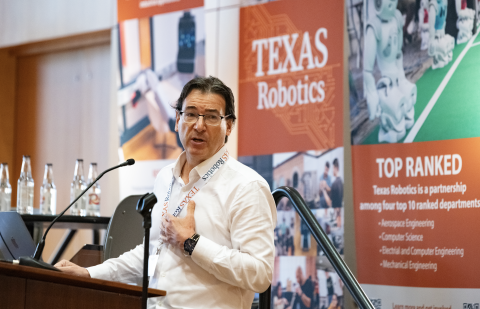News
Faculty Spotlight, Dr. Luis Sentis
Exploring the Integration of Robotics in our Communities

The influence of robotics in our daily lives is becoming increasingly prominent, evident in the self-driving cars navigating the streets of Austin and robot-assisted service on display in some restaurants. No one understands these developments better than the robotics researchers who are at the forefront of advancing these technologies. Among them is Dr. Luis Sentis, a Texas Robotics core faculty member who has long contemplated the future of robotics in society. However, he firmly believes that the decision regarding the extent of robotic integration should rest with the community rather than solely with researchers, engineers, or corporations.
Dr. Sentis is actively engaged in research aimed at laying the groundwork for understanding the role of robots in our communities. He is examining the potential presence of robots on the University of Texas at Austin (UT Austin) campus through the NSF-funded project "Community Embedded Robotics." This collaborative endeavor draws expertise from nine faculty members spanning various disciplines within UT Austin's College of Engineering, School of Communication, School of Information, Department of Computer Science, and Texas Advanced Computing Center (TACC).
With his faculty colleagues in Texas Robotics, Dr. Hart and Dr. Biswas, Dr. Sentis seeks direct input from students regarding their receptiveness to the idea of robots on campus. This involves conducting initial focus groups and surveys to gauge students' perceptions of safety, comfort, and overall acceptance of robots within their campus environment.
Furthering their investigation, the researchers collect physiological data from participants during live demonstrations involving robots such as Spot and Go1, deployed within the Anna Hiss Gymnasium. These robots perform various tasks including navigation, tour guiding, and lost item retrieval. Meanwhile, UT Students observe these tasks while wearing biometric monitors to measure physiological responses.
Subsequent post-deployment interviews provide valuable insights as faculty members debrief with students, reflecting on their experiences and observations. Although the project is still ongoing, two years into its anticipated five-year duration, Dr. Sentis notes significant findings regarding the stress individuals may experience in the presence of robots.
Collaborating with the Texas Advanced Computing Center (TACC), the research team aims to harness collected data to develop comprehensive models and establish a public dataset. This initiative is intended to facilitate informed decision-making and support the formulation of compliance and safety policies for the responsible deployment of robots in our communities.
Dr. Sentis envisions that the outcomes of this project will serve as a valuable resource for companies and organizations involved in the development and implementation of robotics technologies. By prioritizing safety and ensuring community comfort, he believes that roboticists can create a better user experience.
The full list of collaborators on this project includes:
Dr. Luis Sentis, Dr. Keri K. Stephens, Dr. Maria Esteva, Dr. Nanshu Lu, Dr. Elliott Hauser, Dr. Justin Hart, Dr. Joydeep Biswas, Dr. Samantha Shorey, Dr. Junfeng Jiao, Ryan Gupta, Emily Norman, Hyonyoung Shin, Yifan Xu, Yao-Cheng Chan, Sadanand Modak, and Zhiyun (Jerry) Deng.